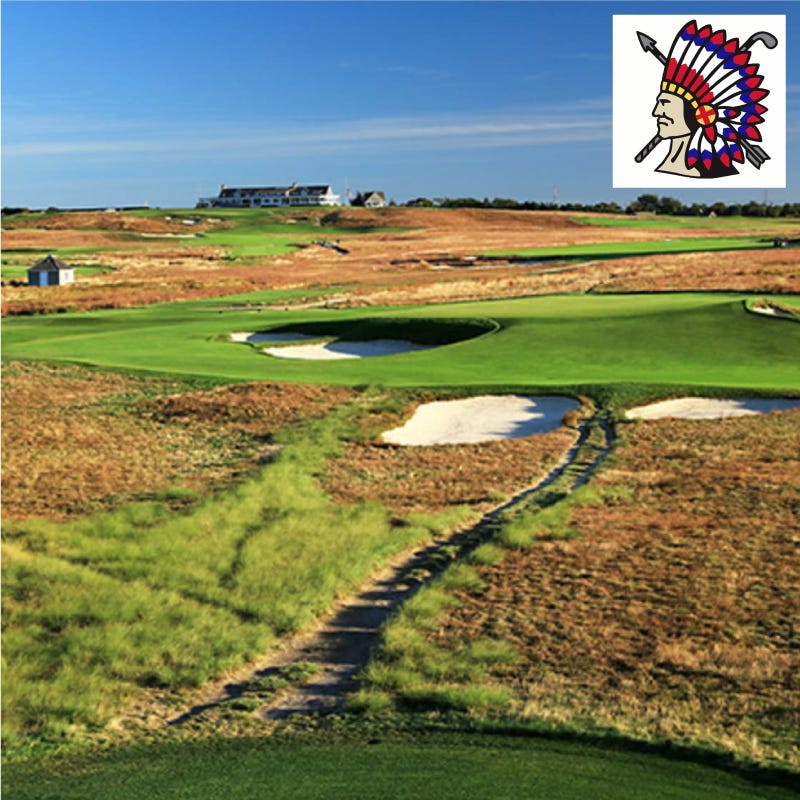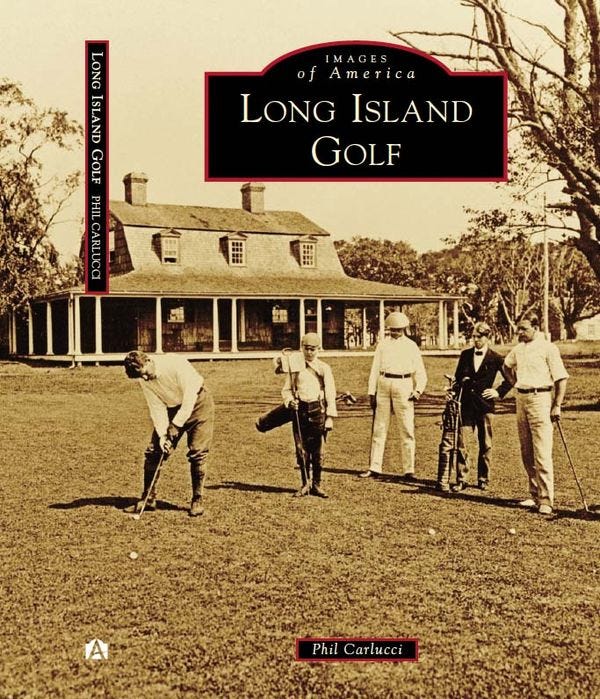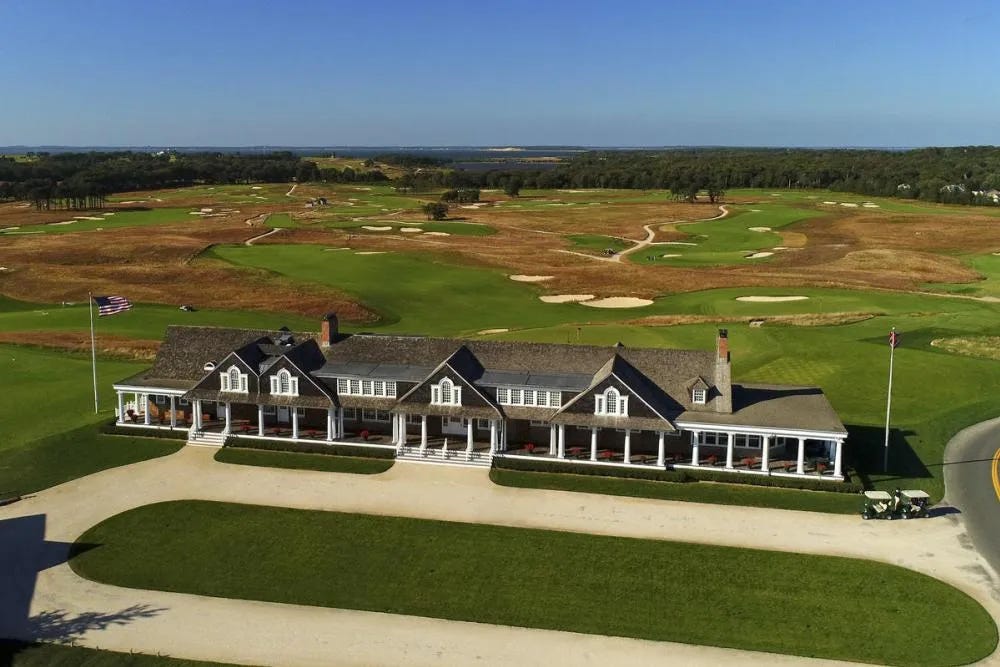preface: i include some of my personal story in this exposé so as to provide context and because perhaps it reflects a wider sense of what is necessary so as to decolonize the entrenched American consciousness and subsequent behaviors, and thus give well-deserved respect and much more to the Original Peoples of Turtle Island.
(Shinnecock Hills Golf Club)
(2018 U.S. Open (one of four “major” golf tournaments) held at Shinnecock Hills. “Demonstrators — some wearing t-shirts featuring a skull with a tribal headdress and the words “U.S. Open Shinnecock Stolen Hills” — carried signs with slogans such as “Stolen land, stolen name, stolen image, silenced voices never!” and “We are the voices of our ancestors.”)
Growing up in NYCity i became enamored with golf at an early age because my father was a weekend golfer; he would get up earlier in the morning on the weekends than during the work week. As a kid i enjoyed the practice putting green, then in my teens ventured to the actual course and became decent enough of a player to sometimes play with him and his golfing friends. Thus golf became both a chance for a city kid to commune with the wooded wilds of Nature and an emotional connector with my father. I played with other people as well, and by myself.
When i started watching on TV with my father, golfers looked like average men with different shaped and sized physiques, a stark contrast with today’s golfing athletes with their entourage of trainers, psychology coaches, and the like. Back then it was more of a game than the big-business global sport it has become. A player winning two or three big tournaments nowadays can earn more than some of the best players used to earn in their careers. To its credit, golf is perhaps the only sport where competitors often congratulate each other on a good shot and share hugs with caddies and rivals at tournament's end.
As an adult – and my father having gone to the green pastures of the spirit world – i used to watch golf for hours on weekends, in part, as a mindless enjoyment after a week of hitting the books, thinking and writing, as well as for the above reasons. After i stopped watching TV altogether, i would occasionally watch some golf online or at least follow the leaderboard, read articles, and watch highlights. Along with keeping up with world news, golf was basically the only mainstream-corporate thing i was following in detail—one of my lifestyle guides is: “starve the beast” ~John Trudell.
While i became aware of the ridiculous prize money and that some of the banks and investment firms sponsoring events were infamous for money laundering and other shenanigans, i followed anyway because i enjoyed the game for the game’s sake, along with learning about the players.
Then in 2024 i cut way back from following in detail though decided to allow myself to follow more closely the coveted four major tournaments which are considered the most prestigious victories of a golfer’s career.
A proverbial straw decision came after learning that the top golfers who were already making obscene amounts of money for – as a Native friend who had dabbled with the sport once remarked to me – “hitting a little ball in a hole,” were given bonuses for their efforts. Granted, many golfers do give back by starting foundations to help others yet the idea of giving millionaires a bonus for playing a game seemed over the top CEO America.
Recently at a local bookstore i saw a book, Long Island Golf. Looking briefly at the beginning, there’s mention of Shinnecock Hills as the first incorporated golf club in 1891… and the seed of this essay was planted. Key word “incorporated.” The course is in so-called Southampton and considered one of the best courses in the world.
So, what happened around that time period that most likely gobs of golf fans are oblivious to? I took a look at my copy of Native American History by Judith Nies (Ballantine Books, 1996):
“1890: U.S. Sherman Antitrust law passed in response to formation of the Standard Oil Trust and other industrial monopolies.”
Wow, if not for that, the oil corporations would control most of what we do nowadays, (pardon the sarcasm).
&
“…Sitting Bull, his son, and six bodyguards were killed. Six policemen were also dead.”
&
“Massacre at Wounded Knee.”
&
”U.S. Indian population fell to its lowest. …By the 1900 census, the total Indian population in the U.S. was 237,196. (In 1300 it was estimated to have been as high as 10 million.) By 1990 it had climbed to 1, 959,234.”
And according to the 2020 census: 3,727,135 — 1.12% of the total US population. And according to another source, in 2025: “ 7,334,949 — 2.14%”
&
”1892: Invention of the gasoline tractor for farming.” And, think golf course maintenance.
Interestingly, “incorporated golf” followed on the heels of the following quote in 1888, from John Oberly, U.S. Commissioner of Indian Affairs: “[The Indian] must be imbued with the exalting egotism of American civilization so that he will say ‘I’ instead of ‘We’ and ‘This is mine’ instead of ‘This is ours.’”
Facing the façade
While following some of the recent Masters major tournament in Augusta, Georgia, i thought again about “hitting a little ball in a hole” . . . yet from the Native perspective. And that got me to see things even further anew.
Colonial golf in America has built a mesmerizing mental façade to go with the “nearly 17,000 golf courses,” and the parent company “Europe has the second-largest regional share with 23% of the world’s total after North America”.
The colonial golf façade in America is based on creating an unquestioned atmosphere of tradition and prestige, including a ‘history book’ with more statistics than you can shake a golf stick at and the already huge getting huger paychecks: “Masters raises purse to $21M with winner getting $4.2M.” Add to all that the individual accolades and glorification of personal achievement—golf reflects the “rugged individualism” of America, superstar privileged style. Famed golfer Rory McIlroy of Northern Ireland has referred to the PGA (Professional Golfers’ Association of America) tour as “the product.”
Façade because i have never heard a professional golfer acknowledge Mother Earth upon whom they all trod and enjoy the sport and make millions—though perhaps such an acknowledgment has been made by the first Native on the PGA tour, Notah Begay III (Navajo (Diné), San Felipe and Isleta Pueblos). The former Stanford University teammate of Tiger Woods had five wins before becoming a TV analyst.
“In 2005, Begay established the non-profit Notah Begay III Foundation. The immediate goal of the foundation was to provide health and wellness education to Native American youth in the form of soccer and golf programs. The broader purpose of the foundation was to stand as a catalyst for change in the Native American community.”
&
”In 2002, Begay founded NB3 Consulting, which consults with tribal communities looking to build golf courses for the purpose of economic development. Notable courses the company has built includes Sequoyah National, Firekeeper Golf Course, and Sewailo Golf Club.”
I also found the following, but don’t know enough about it as to comment:
“Golf course architect Gene Bates knew he needed to follow a core Coeur d’Alene Tribe tenet in the designing of Circling Raven Golf Club. ‘They wanted to make sure, and were very firm,’ Bates said, ‘that we use the land very wisely in the sense that it respected the wetland environment, it respected wildlife corridors and that we didn’t massively clear trees.’ … Bates is not the only course architect to receive such a tribal directive.”
Adding to the transcendent deification of the PGA golfing elite, longtime CBS announcer Jim Nance referred to McIlroy’s recent quest to win the “grand slam” (all four majors in a career) as: “trying to become one of the immortals.” McIlroy did in fact accomplish that feat on April 13, becoming only the sixth player to do so. In the sporting world, it is truly a monumental accomplishment and the tournament itself was about as exciting as golf can be.
After making the winning putt on the first playoff hole, the 35-year-old McIlroy went to his knees on the putting green, his hands clutching his sobbing head, tears falling from his eyes. Having been a golfing child prodigy in Northern Ireland, he later thanked his parents for the sacrifices they made so that he could train and tour the world. He is one of the most popular players on the tour.
Historical precedents
Perhaps more than any other sport, golf ties in with colonialism because of the huge swaths of land used (including chopped trees) to play and the symbolic flags, one for each of the eighteen holes.
In her book Ceremonies of Possession in Europe’s Conquest of the New World, 1492-1640, Patricia Seed shows how the ‘planting’ of “royal banners,” beginning with Columbus in 1492, was considered as instituting “Spanish authority over the New World.” That, along with the English obsession for “boundaries and boundary markers” and “fencing or enclosing…critical to early colonists because it was the customary means of establishing private property,” are the two most defining features of the colonial golf format—not to mention suburbia in general.
Golf itself admits to the boundaries, as it is referred to as a game played “inside the ropes”:
“‘Inside the ropes’ refers to the cordoned-off areas of the golf course where the pro players, their caddies, match officials and television broadcast personnel walk during tournament play.
“‘Outside the ropes’ refers to areas on the golf course during pro tournament play where the fans are allowed.”
And further outside the ropes are the Original Peoples of Turtle Island along with other so-called minorities.
Environmental concerns
For lack of doing an in-depth study, i’ll simply cite two views, one positive and one negative, about the effects of golf courses on local habitats. My sense is that the latter is most accurate.
According to the USGA (United States Golf Association):
“The total land area devoted to golf in the U.S. is relatively small, but courses can offer substantial environmental benefits – especially in developed areas where green space is increasingly limited.
Turfgrass and other vegetation on a golf course help cool highly developed areas during hot weather.
Golf courses provide important habitats for native wildlife and vegetation and can help support threatened species.
Golf courses can help manage stormwater runoff, aiding in flood prevention. They also recharge groundwater supplies and filter surface runoff.
The vegetation on golf courses sequesters atmospheric carbon and helps improve air quality, especially in urban areas.
“The United States comprises 2.3 billion acres of land, of which 70% to 74% (around 1.68 billion acres) are classified as various types of agricultural land and forest. The remaining 26% to 30% is made up of parks, wildlife areas, wetlands, tundra, unproductive woodlands and urban land.”
”Unproductive woodlands” reflects a colonial-corporate mentality.
An article “Why Are Golf Courses Bad for the Environment?” provides information in the following categories:
“water waste, impact on local water supplies, chemical runoff, fertilizer pollution, pesticide and herbicide concerns, soil contamination, habitat loss and fragmentation, machinery and equipment,” and more.
“During NBC’s [2020] coverage of the BMW Championship, Paul Azinger [golfer turned analyst] pulled a Lorax and spoke for the trees. The gist was that he likes them, and he thinks too many courses remove too many of them, making the game too easy for the best players in the world.”
The land itself aka Mother Earth herself
“The controversy surrounding the club [Shinnecock Hills] comes from a claim by the Shinnecock Indian Nation that the property on which the club is located was seized illegally in a white land grab in 1859. The original 80-acre parcel was purchased for $2,500…and members of the Shinnecock Indian Nation helped with construction of the golf course.
“The Shinnecock Indian Nation filed a lawsuit against the State of New York in 2005, seeking the return of 3,500 acres to the tribe in addition to billions of dollars in reparations. Native American representatives claim Shinnecock Hills Golf Club is located on the nation’s tribal burial grounds.
“The core of the lawsuit is over a 1703 land deal between Southampton and the tribe for a 1,000-year lease. The suit charges that a group of powerful investors conspired to break the lease in 1859 by sending the state legislature a fraudulent petition from a number of Shinnecock tribesmen.
“Although other tribal members immediately protested the petition was a forgery, the legislature approved the sale of 3,500 acres of former tribal land.
“The Shinnecock Indian Nation lost the 2005 lawsuit in court and the U.S. Court of Appeals in Manhattan upheld the ruling in October of 2016. Later in the year, the United States Supreme Court declined without explanation to review the decision. …”
&
“Attorney Kelly Dennis, …said the golf club is one of the defendants named in the tribe’s land claim suit, on which the U.S. Supreme Court chose not to rule in 2016, and noted the tribe has never received compensation for the use of its image on the club’s logo.
“‘It’s an added insult that the golf club, local government, and other businesses led by the colonists’ families benefit from the U.S. Open and USGA when the Shinnecock Tribe is marginalized and left out of any meaningful recognition and economic development,’ said Dennis in a designated “free speech” area located across the street at Stony Brook Southampton College.
“‘We are using this major event at the [2018] U.S. Open to exercise our free speech when Shinnecock people have been denied the legal right to exercise political and civil rights to obtain justice for the outstanding land claim that includes the Shinnecock Hills and many other issues not limited to grave protection, clean water, natural resources, fishing, hunting, racial injustices, and perpetuated stereotypes.”
(For a general legal and historical overview of the land/property aspect, see Peter d’Errico’s two-part article, “Property, Domination, Married Women, 'Indians'.”)
Worlds apart yet connected because of the land
To wrap up this little exposé, I present a contrast to be looked at as a kind of Zen kōan so as to non-judgmentally ponder the differences between various Peoples who are able to travel the world and play a sport “inside the ropes” and First Peoples who are excited to simply be able to see each other and say “good to see you!”
The 2025 Masters went to a playoff after McIlroy missed a short putt on the last hole; he would soon make a shorter putt to win on the first playoff hole. There was a lull in the broadcast before the playoff, so i started listening to a First Voices Radio interview with Maori artist George Nuku (Scottish, German and Maori descent from Aotearoa) who said, about First Peoples:
“We’re like these trapeze artists… balancing between being agents of the changes and being victims of the changes…. And all of us knowing how far we’ve come, and how much our old people, what it cost, what it cost, how they, what they did so that we could be in that situation of seeing each other again and saying, ‘Hey man, it’s good to see you again!, you know, wow!, what took you so long, George!’”
The wonder and joy of a simple greeting and meeting between First Peoples after hundreds of years of colonization … Winning golf’s grand slam after 11 years of attempting to.
A vast wild wilderness filled with stories and sustenance, seeds and star knowledge … A precisely manicured sporting environment with concession stands and a merchandise tent.
My father once took me to a tournament when i was a teen and i clearly remember the excitement of being able to see in actuality what had previously only been seen on TV . . . that little white ball traveling hundreds of yards in the air . . . then softly bouncing onto the putting green as if dropped from a spaceship . . . and rolling toward the hole.
In 2004 i took my teenage nephew to a practice round of the 104th U.S. Open at Shinnecock Hills. I’m not much of a drinker and on the rare occasion that a shot glass is placed before me, it might take me an hour to sip it all, but wanting a little souvenir to remember the day, i purchased a shot glass with the golf club’s logo and “104th U.S. Open – Shinnecock Hills” embossed in white on the clear glass. I don’t remember ever having actually used it, though maybe once — but there it sits on a kitchen counter behind the spices. That little piece of glass fondly holds the memory of a day shared with my nephew, but as to the incorporated sport of golf, as Bob Dylan sings in his song from 1999, “I used to care, but things have changed.”
— — — — — — — — — — — — — — — — — — — — — — — — —
Mankh (Walter E. Harris III) writes, publishes, gardens, travels a holistic mystic Kaballah-rooted pathway staying in touch with Turtle Island. To find out more about his writings, publishings, podcasts, presentations… Allbook Books










Very interesting Mankh. Not being a golfer I have always thought golf courses were a scar on the natural land, and deplored the chemicals and water used, the trees disappeared. However I know it is a beloved past time by many. Hope your weaning yourself away was replaced with a new found joy and pleasure.
Thanks for putting what I know in my heart into words. I hadn't noticed how symbolic golf was of colonization, and now I'll never forget. In the Sonoran Desert, those golf courses look like green scars on the desert, built over what previously had been among the most beautiful and biodiverse places.